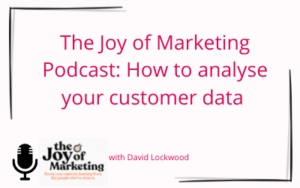Google’s decision to switch off third-party cookies by the end of 2021 has naturally left many multi-channel retailers questioning how they will continue to reach their target audience. In our latest retail leaders discussion, we welcomed data protection and marketing expert, Julia Porter from Data Protection Network, to shed some light on the implications, as well as how brands can prepare.
Essentially, the demise of the third-party cookie will make it harder for brands to carry out a great deal of their marketing activities. This includes sequential advertising campaigns. Although there are many alternative data solutions emerging, as Julia explains, it can be difficult to know which approach is best for each business. So, let’s take a closer look at the cookie issue.
Which type of data should you be collecting?
First-party data is perhaps the most accurate information you will collect, coming directly from your customers and prospects. Meanwhile, second-party data is the information you might share with close brand partners – with permission – in a one-to-one environment.
Third-party data, on the other hand, refers to a wide range of audience insight that many brands have relied on until now to build a broader picture of their target customer. The problem is that it can include a wealth of personal data which has been shared across several disparate platforms over time. This means it can be hard to track down where the information came from originally, and crucially, whether the consumer gave specific permission for their details to be shared in this way.
Why are major platforms switching off cookies and how will it affect retailers?
Firstly, it’s important to note that although browsers are no longer supporting third-party cookies by actively letting them through, they haven’t actually blocked them altogether. Whereas cookies in Chrome are currently switched on by default unless the user turns them off, by 2022 they will be switched off by default. This does of course mean that a large proportion of online audiences are likely to become invisible in one fell swoop. So, what’s behind this shift?
Most online advertising is carried out programmatically, through a process known as Real-Time-Bidding (RTB). This means that advertising inventory is bought and sold automatically through Demand-Side Platforms (DSPs) and Sell-Side Platforms (SSPs). However, between these platforms sit sophisticated Data Management Platforms (DMPs). Over the years, these platforms have developed technology such as machine learning to harvest and segment huge volumes of consumer data without necessarily having the right permissions in place to do so. Not only is data compromised, but it also means that over a third of consumers (36%) are turning to ad blockers to prevent being bombarded with irrelevant or repetitive messaging. In response to this, Apple, Mozilla, Microsoft, Amazon, and now Google, are switching off their cookies.
Ironically, as a consequence of this movement, smaller brands who advertise on these large tech platforms are finding it harder to gain full visibility into their campaigns and maintain a direct connection with their customers. Over time, they will be forced to spend more money on these platforms in order to reach the same audience.
Another more immediate issue is that much of the chat functionality on retail websites is currently reliant on third-party cookies, as well as retail services and channels such as Twitter, Trustpilot, Global-e, Vimeo or Stripe Payment, to name just a few.
Therefore, now is the time for brands to consider refocusing their marketing strategy around their own first-party data.
In our next post, Julia helps us explain the steps retailers can take to pivot away from the cookie.




